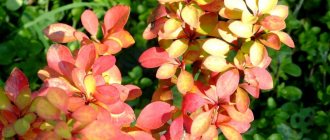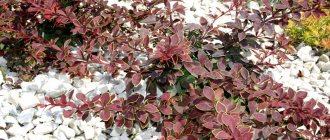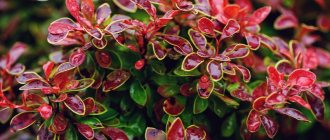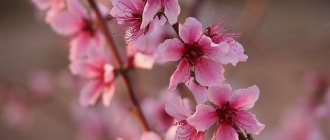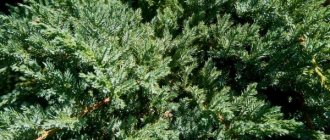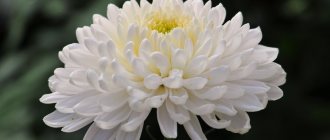Description
Barberry Golden Ring forms spreading bushes up to 90...100 cm in height and width. The shoots are mostly straight, directed in different directions, the bark is dark.
The leaves are predominantly obovate in shape with a slightly pointed tip. The surface of the sheet is glossy, shiny. The leaf color is carmine red or dark purple with a thin yellow border.
Flowering usually occurs at the end of May. The flowers are mostly solitary, yellow, small. The berries ripen in September: ripe berries are coral-red in color. They usually stay on the branches until January, sometimes almost until spring.
Correct Observation
If we talk about already mature shrubs of this plant, they do not require much care. The only condition for their normal growth is sufficient moisture during planting and rooting.
It is necessary to irrigate the planted shrub when there is significant drying of the soil under the crown. It is very important that the soil is loose. Then oxygen and moisture will be delivered to the barberry root system.
You can maintain moisture and improve the structure of the soil under the crown using the mulching method. For these purposes, a layer of peat is used, the thickness of which is 8 cm.
In order for the plant to please you with its attractive appearance for a long time, you must adhere to the following simple recommendations:
- Starting from the 2nd year of life, the bush should be fed with nitrogen-containing fertilizers. This plant responds well to irrigation, which will be diluted with an infusion of mullein or bird droppings.
- Before the barberry begins to bloom, it is worth feeding with fertilizers containing microelements. The best option would be to use granular products. They allow you to gradually enrich the soil under the crown.
- In September, apply 10 g of potassium fertilizer and 15 g of superphosphate under the bush. This dosage is calculated for one bush.
It is not recommended to apply fertilizer every day. Barberry will grow normally provided that fertilizing is done 2-3 times a year.
video of Thunberg barberry planting and care:
Use in landscape design
Used mainly in tree, shrub and shrub compositions to create color accents. Looks good with low-growing conifers, as well as with other small barberries, such as Thunberg barberry "Golden Nugget" or "Green Carpet". Suitable for forming low hedges.
Rules for planting barberry shrubs
You can plant the plant in the spring, when the soil is already warm enough. It is important to plant before the buds begin to bloom on the seedlings. Very rarely planting is carried out in the fall. Since barberry is an unpretentious plant, it can grow in open areas. He is not afraid of drafts or strong winds.
When planting barberry, it is necessary to take into account the fact that neutral soil is suitable for it. In this case, the pH level can reach levels above 7. If the soil has high acidity, then liming is necessary to eliminate it. For these purposes, prepare the following solution: 8-10 kg of humus, 100 g of superphosphate, 400 g of slaked lime, 200 g of wood ash.
This article provides a description of the plum variety Alyonushka.
This article provides a description of the Iput cherry variety.
You can see what the Tarusa raspberry tree looks like from this article here: //gidfermer.com/sadovodstvo/yagody/malina-tarusa-opisanie-sorta.html
If a single crop is planted, then it is necessary to maintain a distance of 2 m between the bushes. For those who decide to plant a hedge, it is necessary to prepare the holes for the seedlings for another week. Their depth will be 40 cm.
video barberry planting and care:
To increase aeration of the root system, a layer of sand is placed at the bottom of the pit. When the pH value shifts in the alkaline direction, the pit should be filled with the solution described above. Do not use ash and lime.
After this, a plant seedling is sent into the prepared hole, sprinkled with soil, compacted, irrigated and mulched. To accomplish the last point, peat or compost is used. That part of the seedling that is on the surface of the ground should be cut off immediately after planting. It is worth leaving only the stem, on which 3-5 developed buds will be present.
Planting and care
Soil: can grow on any non-saline soil with a pH of 6.1...7.8, including poor and rocky ones. Prefers loose and highly fertile soils, underlain by sand or sandy loam. Moisture: undemanding, tolerates heat and drought well. Does not tolerate stagnation of moisture in the soil. Lighting: light-loving, but can grow in partial shade. With a lack of light, the leaves lose their carmine-red hue and become greenish. Winter hardiness: USDA zone 4a, bushes winter well in Moscow, the Moscow region and most regions of Russia.
The best time for planting is April, but plants from containers can be transferred until autumn. After planting, barberry must be watered. In the first year it is necessary to maintain more or less constant moderate soil moisture. In the future, watering is vital only during very long droughts.
Feeding is optional, but recommended. Nitrogen fertilizers should be used with caution in the second half of summer.
In spring, sanitary and formative pruning is required. Old shoots can be cut into a ring.
Thunberg barberry tolerates pruning well during the growing season and recovers quite quickly after it. Therefore, hedges can be formed in summer.
Reproduction
Reproduction of Barberry Thunberg Golden Ring is carried out:
- seeds;
- cuttings;
- dividing the bush.
To propagate using seeds, it is necessary to prepare planting material. Seeds should be collected only from the ripest fruits, dried and processed by soaking in a pale pink solution of potassium permanganate for 20 minutes.
Seeds can be sown in late autumn directly into the ground. During the winter months they will undergo natural stratification. When planting in spring, the seeds are buried in damp sand and placed in the refrigerator for 2 months for artificial stratification. After this time, the sprouts can be planted into open ground. Of all the young shoots, after a year it will be necessary to select the strongest ones and transplant them to a permanent place.
To propagate shrubs using cuttings, it is necessary to collect material from young shoots of the first year of vegetation. A future cutting no more than 10 cm long is cut out from the middle of the shoot.
Important! The cut cuttings should have one internode and a pair of leaves.
The upper part of the cutting should be cut strictly horizontally, while the lower part should be cut at an angle of 45 °. Next, the cutting is placed in an aqueous solution with a rooting agent (kornevin, heteroauxin) for a week. Only after this can it be planted in the ground under cover. Watering the planted cuttings is carried out as necessary, but loosening the soil must be done at least 2 times a week.
By dividing the bush, Thunberg Golden Ring barberry can be propagated only after it reaches 5 years of age. To do this, the bush must be carefully dug up and the root shoots divided into 3 parts, after which the finished seedlings can be planted again in the ground.
Reviews
There are few informative reviews about Golden Ring barberry.
- Moscow: the yellow border appeared only in the second year, in the first year the leaves were simply purple;
- Moscow: in winter the ends of the branches freeze slightly, in the upper part, but the bush still grows by 10 centimeters per year;
- Moscow: in 2012, the barberry was severely frozen and took several years to recover;
- Belarus, Grodno region: the bush grew very quickly from a small seedling to half a meter, winters well. It grows in bright light and the yellow border appeared already in the third year.
If you also grew this barberry, please leave your feedback in the comments to the article. It will be useful to other readers of the portal.
Barberry hedge
Barberry seedlings are very often used to create decorative impenetrable walls. Foliage adds brightness, richness and color to the landscape, and thorny shoots will protect your area from uninvited animals. Such walls can “hide” the area from the prying eyes of neighbors or zone the space on your site. If you plant low-growing varieties in a row, neat, very beautiful borders will appear on your site, which can advantageously frame flower beds and flower beds or garden paths.
Barberry thunberg "Erecta" is a columnar-shaped shrub that grows one and a half meters in height.
It has soft green foliage, acquiring red-orange hues in the fall. Can create picturesque decorative walls in your garden. It tolerates pruning and trimming well, but free-growing hedges also look very impressive. In May it is covered with red-yellow inflorescences, which stand out against the background of the leaves. Unpretentious in care and resistant to external growing conditions, barberry is recommended for growing by novice gardeners. In September - October, the bush is decorated with red berries, reaching 1 cm in diameter. They look gorgeous almost all winter. If you want to create a bright and colorful hedge on your site, we recommend taking a closer look at the thunberg barberry “Maria” (Maria). A very beautiful and noticeable shrub will highlight any landscape style and enliven a calm landscape. It has foliage on which you can see many colors: yellow, green, red, brown, and even pink, depending on the time of year. Seedlings grow up to 1.5 meters in height, acquiring a columnar crown shape with age. In May, decorative yellow flowers appear on the bush, and by autumn bright red berries ripen.
Barberry thunberga 'Atropurpurea' is another variety that is often used in living walls. Growing 1.5 meters in height, the shrub has a dense, rather spreading crown. The foliage is dense, elegant in shades of purple, and by autumn it becomes variegated thanks to pink splashes. The seedlings hold their shape well and can easily withstand various cuttings and shaping. Flowering begins in May and during this period the bush is covered with numerous yellow flowers, attracting the curious glances of passers-by. The fruits of barberry are no less decorative: bright red, oblong, reaching 10 mm in length. They are not edible, but very decorative.
Diseases and pests of barberry
The downside of barberry is its tendency to powdery mildew. This most often occurs during rainy summers. The leaves become covered with white spots, on which droplets of liquid are sometimes visible. The way to combat this disease is to treat the plantings with fungicides.
Leaf spots and rust also occur (Amur barberry is practically not affected by them). Control methods are the same as for powdery mildew.
To prevent such diseases, it is recommended to treat shrubs with Bordeaux mixture in the spring.
Among the insects that can parasitize barberry are aphids, sawflies and moths. Systemic insecticides help control these pests.
